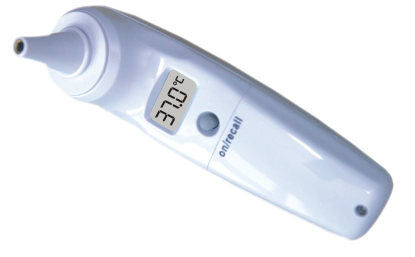
Infrared Ear Thermometer
With so many medical thermometers available on the market, it can be difficult to decide which one is right for you. To help make that decision a little easier, this article takes a closer look at infrared ear thermometers and explains how they work, their advantages and disadvantages, and why they might be a good option for your health needs.
Packing:plastic case, colored paper box, 20pcs/ctn.
| Ref. No.: | Size: | Weight: | ctn size: |
|---|---|---|---|
| NMDE102301 | 134x70x34mm | 81g.(include battery) | 49x27x20cm |
An infrared ear thermometer is a medical device that uses infrared technology to measure the temperature of the ear. The thermometer is placed in the opening of the ear and emits a brief pulse of infrared light. The light is absorbed by the eardrum, and the resulting signal is used to calculate the temperature of the ear. Infrared ear thermometers are safe for all ages and can be used on both ears. They are quick and easy to use, and they provide accurate readings within seconds.
One of the most popular types of ear thermometers is the infrared ear thermometer. Here are some benefits of using an infrared ear thermometer:
1. They are quick and easy to use.
2. They are more accurate than other types of ear thermometers.
3. They are less invasive than other types of ear thermometers.
4. They can be used on all types of patients, including infants and young children.
Most infrared ear thermometers are considered safe for both children and adults. However, there are a few safety concerns that you should be aware of before using one. One safety concern is that infrared ear thermometers can give off harmful levels of radiation. If you use an infrared ear thermometer too often, you could increase your risk of developing cancer. Another safety concern is that infrared ear thermometers can cause burns. If you use an infrared ear thermometer on someone who has a fever, you could accidentally burn their skin. Finally, you should be careful when using an infrared ear thermometer on infants and small children. Their ears are much more delicate than ours, so they could be easily injured by the thermometer. If you have any concerns about using an infrared ear thermometer, talk to your doctor or a healthcare professional before using one.
If you're in the market for an infrared ear thermometer, you'll want to know about the different types that are available. Here's a rundown of the most common types of infrared ear thermometers:
1. Dual Mode Infrared Ear Thermometer: This type of thermometer can be used for both adults and children. It has two modes – adult and child – so you can get an accurate reading regardless of who you're measuring.
2. Forehead Thermometer: A forehead thermometer is a great option if you want to avoid having to insert the thermometer into the ear canal. Simply place it on the forehead and press the button – it's that easy!
3. Digital Infrared Ear Thermometer: A digital infrared ear thermometer is a great choice if you want accuracy and convenience. Simply insert the probe into the ear canal and press the button – it's that easy!
4. Traditional Mercury Thermometer: While mercury thermometers are not as common as they once were, they're still available if you prefer this type of thermometer. Simply insert the probe into the ear canal and wait for the mercury to rise – it's that easy!
If you are looking for an infrared ear thermometer, there are a few things to keep in mind. First, make sure that the thermometer is FDA cleared. Second, check to see if the manufacturer offers a money-back guarantee. Third, find out if the seller offers free shipping and handling. Fourth, read customer reviews to get an idea of what others think of the product. Finally, compare prices between different sellers before making a purchase.